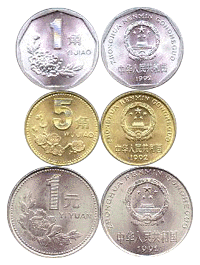_a.jpg) The fourth series of RMB began being issued on 4/27 1987, until 4/1 1997. There were 9 denomination, 14 different notes, which includes 1 type of 1 Jiao, 1 type of 2 Jiao, 1 type of 5 Jiao, 3 types of 1 Yuan (1980, 1990, 1996), 2 types of 2 Yuan (1980, 1990), 1 type of 5 Yuan, 1 type of 10 Yuan, 2 types of 50 Yuan (1980, 1990), and 2 types of 100 Yuan (1980, 1990). The fourth series of RMB began being issued on 4/27 1987, until 4/1 1997. There were 9 denomination, 14 different notes, which includes 1 type of 1 Jiao, 1 type of 2 Jiao, 1 type of 5 Jiao, 3 types of 1 Yuan (1980, 1990, 1996), 2 types of 2 Yuan (1980, 1990), 1 type of 5 Yuan, 1 type of 10 Yuan, 2 types of 50 Yuan (1980, 1990), and 2 types of 100 Yuan (1980, 1990).
The fourth series had the longest designing process. It takes 18 long years to make the plan final from the proposal in January 1967 to May 1985. In this period, the process has suffered from interference from the extreme left wings, and ultimately succeeded.
In January 1967, PBC reported to the State Council about the complains from mechanical engineering students from Hubei that there is no portrait of Mao Tse-Tung or propaganda on the 1 Yuan note. They also provided their suggestion toward the new design. In February, Li Xian-Nian commented, "should prepare for a new series, which reflects primarily on the production theme, and overcome the production difficulty occurred during the production of the third series". On 7/16 1968, the main branch of PBC reported the new draft to the State Council. The new draft includes "three outstandings" (the glory of Chairman Mao outstanding, the philosophy of Chariman Mao outstanding, and the revolutionary approach of Chairman Mao outstanding) and "two reflections" (reflection of proletariat revolution, reflection of socialism) as the main theme. At that time, Prime Minister Zhou was under serious political attack. On 4/8 1969, the PBC again reported another draft with content of extreme left wing thinking. Yet it was not approved either. On 11/18 1975, the Ministry of Finance (PBC was merged with Ministry of Finance then) made a third report in regard to the new RMB series, the draft reflected new things under socialism and portrait of industrial workers, farmers, and soldiers. On 12/29, Lee Xian-Nian commented, "wait and see". On 5/10 1976, the same proposal was asked again, Lee commented, "not considering at of now". All three proposals reflect the extreme left wing during the Cultural Revolution. With the correct instruction under the Communist Party and the State Council, all proposals were rejected so that the extreme thought would not show on the national currency.
After the surrender of the "Gang of Four", the Ministry of Finance once again reported a new proposal of the new series, which describe both the design, the need, and the possibility on 11/15 1977. Soon after, it was approved by the Political Bureau of the CPC Central Committee on 11/21. In April 1978, according to the State Council, PBC first organized printing technicians for research. In November, artists from Central Academy of Fine Arts and Central Academy of Arts and Design (the latter is now part of Tsinghua University) and printing experts gathered to work on the design of series four from ground zero. After extensive working period, the final color draft was completed on 12/8 1979 and was approved on 12/20 by the State Council (50 Yuan and 100 Yuan were not in the draft then). On 2/24 1983, PBC reported the paper about printing and issuing the fourth series. The State Council approved it on 3/3.
During the process of designing the fourth series, PBC suggests the possibility of larger denomination according to increasing volume of transaction. The denominations proposed were 20 Yuan with Mount Tai and XinHua Gate, 50 Yuan with People's Congress Hall and the Three Gorges of Yangtze River, and 100 Yuan with Tiananmen and the Great Wall, designed by Beijing Banknote Printing Factory. On 11/4, PBC officially reported about printing the three large denomination notes, but it was not approved. On 2/29 1984, PBC tried again, the feedback from the State Council was "approved, time of issuance not yet decided". On 10/23, the Bank reported about the time of issuance and the theme design, which describes that the original three large value notes were different from the previously approved 1 Jiao to 10 Yuan. After the experts redesigned them, 20 Yuan was canceled, 50 Yuan had a male industry worker, a farm girl, and an intellectual man on obverse, and the Hukou Waterfall of Yellow River on reverse, 100 Yuan had four leaders Mao Tse-Tung, Zhou En-Lai, Liu Shao-Qi, and Zhu De on obverse, and Mount Jinggang on reverse. The 50 Yuan and 100 Yuan were targeted as accessory denominations. In May 1985, the State Council approved it, the fourth series was completed.
 The 1991 coins series was based on previous coins series with necessary modifications. The 1 Jiao, 5 Jiao, and 1 Yuan coins were put into public on 6/1 1992. The composition, image, specification, and minting technology had achieved an ideal level. With older series, the new series strengthen the coin system of China. The 1991 coins series was based on previous coins series with necessary modifications. The 1 Jiao, 5 Jiao, and 1 Yuan coins were put into public on 6/1 1992. The composition, image, specification, and minting technology had achieved an ideal level. With older series, the new series strengthen the coin system of China. | |